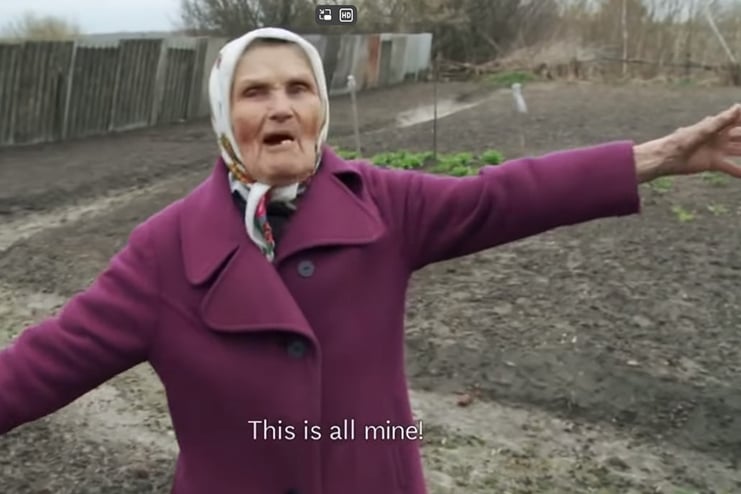Ordinarily, one would expect a story about Chernobyl to be depressing. But that’s not the case with the documentary The Babushkas of Chernobyl (2015). Directed by Holly Morris and Anne Bogart, it tells a story of three grandmothers—babushkas—who are living in Chernobyl’s so-called “Exclusion Zone,” a toxic and radioactive area where Chernobyl Nuclear Power Plant’s Reactor 4 exploded on April 26, 1986.
At the time of the explosion, everyone in the “Exclusion Zone” was told to relocate but a few residents braved the guards and the barbed wire to sneak back into their homes. The seeming insanity of that choice, because exposure to that much radioactivity likely mean death, raises another question: Is it really crazy to wish to live on one’s own land, be independent, and have a few moments of happiness vs. living someplace one does not wish to be just to avoid the possibility of an earlier death?
It turns out that these grandmothers were driven not only to survive but to thrive. The land has renewed itself, the sun is shining, and the birds are chirping … but so are the radiation meters. All of the strangeness of humanity, including various profiles of good and evil, seem to be contained in this “Exclusion Zone.”
Happiness in Chernobyl sounds like the title of some satirical play but these babushkas are resilient and, in fact, happy. Their happiness is not of any silly variety but of that “settled in one’s existence” sort of happiness. They are satisfied with their world, and it is familiar to them. They fish, they grow vegetables and fruits, they have chickens and pigs. It sounds like an idyllic kind of farm life, except that they also live with regular check-ups from the Ukrainian government. (They also get a small monthly pension—that is, when the corrupt system is not in the way. At the time of the filming, their pensions were four months late.)
In between making moonshine and raspberry preserves, the babushkas welcome into their homes government officials who take samples of their water and food to check the radiation levels. The women are regularly tested and measured. On one occasion, one of the grandmothers is sitting in a chair while her level of radiation is measured. “Nothing out of the ordinary,” says the official. He treats her with respect and good humor.
How is it possible that these women, some of whom survived Stalin’s famine in the Ukraine, World War II, and the Chernobyl disaster, are still alive? One of the government officials notes that people who left the area died faster. You might expect from cancer but the man says, “They died from anguish.” They died from missing their home.
These women, at the time of the filming, were in their 70s and 80s. One of them had thyroid cancer but she survived it. Others, it appeared, were not sick in any way that would stop them from doing their daily chores. Younger people cannot comprehend why these women choose to stay. This not only reveals a generational gap but also a different way of looking at life and finding meaning within it.
One of the implicit questions that comes up in the documentary is: What is home? These grandmothers are as stubborn as hell, as if they are staying in the “Exclusion Zone” out of spite. But this same stubbornness is what makes them incredibly independent. They are refusing to submit to authority and, amusingly, this authority that patrols the area, engaging in mundane bureaucratic tasks of “dealing with” Chernobyl’s disaster after all these decades, is powerless over this unique brand of Slavic stubbornness. The grandmothers are firm in their beliefs, and happy in their way, but this does not mean that they are, at the same time, not full of sadness.
They allow themselves to cry as well as to laugh but the mourning is brief, as if it’s a waste of time on God’s earth. It’s impossible to escape the outcome and the aftermath of Chernobyl, and the grandmothers understand it. But as one of them said, it’s not the radiation that worries her, but starvation. Surviving Stalin’s famine has left an indelible mark on her soul.
Perhaps these grandmothers’ lives are too simple but that does not make them any less meaningful. There is a sense of ritual and observance that still happens in this condemned area. The women visit one another. On one occasion, they share an Easter meal together, reminiscing about the time when they were young. Memory is powerful and strange, and the grandmothers immediately remember a particular song that was sung at dances in days long gone. Suddenly, they are young again, smiling, separated from the darkness and evil they will eventually experience.
One scene is especially poignant—the grandmothers have no way of going to the church. It’s Easter, and they take a bus outside of the “Exclusion Zone” and attend the Orthodox Mass. One of them brought her moonshine to be blessed. “You can’t bless the moonshine,” a younger woman tells her. “Why not? If you can bless the wine, you can bless my moonshine too!” There is a mischievous smile on her face but she’s also a woman who is humble before God. These babushkas’ lives are evidence that God exists everywhere, and that while destruction can often reign supreme, creation, however small, affirms our propensity for the good.

Leave a Reply